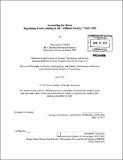| dc.contributor.advisor | Deborah K. Fitzgerald. | en_US |
| dc.contributor.author | Frohlich, Xaq Zachary | en_US |
| dc.contributor.other | Massachusetts Institute of Technology. Program in Science, Technology and Society. | en_US |
| dc.date.accessioned | 2011-09-27T18:35:17Z | |
| dc.date.available | 2011-09-27T18:35:17Z | |
| dc.date.copyright | 2011 | en_US |
| dc.date.issued | 2011 | en_US |
| dc.identifier.uri | http://hdl.handle.net/1721.1/66037 | |
| dc.description | Thesis (Ph. D. in History, Anthropology, and Science, Technology and Society (HASTS))--Massachusetts Institute of Technology, Program in Science, Technology and Society, 2011. | en_US |
| dc.description | Cataloged from PDF version of thesis. | en_US |
| dc.description | Includes bibliographical references (p. 456-493). | en_US |
| dc.description.abstract | This dissertation traces a transformation in the U.S. Food and Drug Administration's governance of food markets during the second half of the 20th century. In response to new correlations between diet and risk of disease, anxieties about (over)abundant food supplies, and changing notions of personal versus collective responsibility in an affluent society, the FDA changed how it regulated food labeling. Following WWII, the agency developed a set of standard recipes with fixed common name labels (such as "peanut butter" or "tomato soup"), or "standards of identity," for all mass-produced foods. However, the appearance of new diet foods and public health concerns undermined this system. Beginning in the 1970s, the FDA shifted its policies. Rather than rely on standardized identities, the agency required companies to provide informative labels such as the ingredients panel, nutrition labels, and various science-based health claims. Agency officials believed that such information would enable consumers to make responsible health decisions through market purchases. Food labeling is explored as a regulatory assemblage that draws together a variety of political, legal, corporate, and technoscientific interests and practices. The five chapters are organized chronologically. The first two describe how a shift in focus among nutrition scientists from concern for the undernourished to a concern with overeating led to the introduction onto the market of engineered foods capitalizing off popular interest in diet and health. A middle chapter describes a series of institutional scandals that generated the political animus to change the FDA's system, and registered a broader "shock of recognition" that Americans' views about food and food politics had changed. The final two chapters describe the introduction of "Nutrition Information" labeling in the 1970s and the mandatory "Nutrition Facts" panel in the 1990s. By looking at the regulation of labels as a kind of public-private infrastructure for information, the turn to compositional labeling can be understood not merely as a shift in representation-from whole foods to foods as nutrients-but more broadly as a retooling of food markets to embed notions about personal responsibility for health into the ways that food was designed, marketed, and consumed. | en_US |
| dc.description.statementofresponsibility | by Xaq Zachary Frohlich. | en_US |
| dc.format.extent | 493 p. | en_US |
| dc.language.iso | eng | en_US |
| dc.publisher | Massachusetts Institute of Technology | en_US |
| dc.rights | M.I.T. theses are protected by
copyright. They may be viewed from this source for any purpose, but
reproduction or distribution in any format is prohibited without written
permission. See provided URL for inquiries about permission. | en_US |
| dc.rights.uri | http://dspace.mit.edu/handle/1721.1/7582 | en_US |
| dc.subject | Program in Science, Technology and Society. | en_US |
| dc.title | Accounting for taste : regulating food labeling in the "affluent society," 1945-1995 | en_US |
| dc.type | Thesis | en_US |
| dc.description.degree | Ph.D.in History, Anthropology, and Science, Technology and Society (HASTS | en_US |
| dc.contributor.department | Massachusetts Institute of Technology. Program in Science, Technology and Society | |
| dc.identifier.oclc | 752195604 | en_US |
